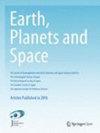Periodic oscillations of Doppler frequency excited by the traveling ionospheric disturbances associated with the Tonga eruption in 2022
IF 2.5
3区 地球科学
引用次数: 0
Abstract
Abstract The explosive eruption of the Hunga Tonga-Hunga Ha’apai volcano on 15 January 2022 generated atmospheric waves traveling around the Earth, which caused ionospheric disturbances on various spatio-temporal scales. A HF Doppler sounding system in Japan detected characteristic ionospheric disturbances showing periodic oscillations in the Doppler frequency with a period of ~ 4 min. In this study, such periodic oscillations were examined by comparing Doppler frequency data with Total Electron Content data obtained by Global Navigation Satellite System. The observed periodic oscillations in the Doppler frequency were characterized by a sawtooth or S-letter shaped variation, implying the passage of the traveling ionospheric disturbances through the reflection points of the HF Doppler sounding system. It was also found that the periodic oscillations occurred prior to the arrival of the tropospheric Lamb wave excited by the Tonga eruption. From the total electron content data, the traveling ionospheric disturbances causing the periodic oscillations were excited by the tropospheric Lamb waves at the conjugate point in the southern hemisphere, namely, the electric field perturbations due to the Lamb waves in the southern hemisphere mapped onto the sensing area of the HF Doppler sounding system in the northern hemisphere along the magnetic field lines. The periodic oscillations were observed only in the path between Chofu transmitter and Sarobetsu receiver, whose the radio propagation path is almost aligned in the north–south direction. This suggests that the traveling ionospheric disturbance has a structure elongating in the meridional direction. The variation in the Doppler frequency was reproduced by using a simple model of the propagation of the traveling ionospheric disturbances and the resultant motion of the reflection point. As a result, the vertical motion of the reflection point associated with the periodic oscillations was estimated to be about 1 km. It is known that 4-min period variations are sometimes observed in association with earthquakes, which is due to resonances of acoustic mode waves propagating between the ground and the lower ionosphere. Therefore, a similar resonance structure in the southern hemisphere is a plausible source of the traveling ionospheric disturbances detected in the northern hemisphere. Graphical Abstract与2022年汤加火山喷发有关的电离层扰动所激发的多普勒频率周期振荡
2022年1月15日,Hunga Tonga-Hunga Ha 'apai火山爆发,产生绕地球传播的大气波,造成不同时空尺度的电离层扰动。日本的高频多普勒探测系统探测到电离层特征扰动,其多普勒频率表现为周期性振荡,周期约为4 min。本研究通过将多普勒频率数据与全球导航卫星系统获得的总电子含量数据进行比较,对这种周期性振荡进行了检验。观测到的多普勒频率周期振荡特征为锯齿状或s字母形变化,这意味着电离层扰动通过高频多普勒探测系统的反射点。在汤加火山喷发激发的对流层兰姆波到来之前,还发现了周期振荡的发生。从总电子含量数据来看,引起周期振荡的电离层扰动是由对流层兰姆波在南半球共轭点激发的,即南半球兰姆波引起的电场扰动沿磁力线映射到北半球高频多普勒探测系统的感应区。只有在Chofu发射机和Sarobetsu接收机之间的路径上观察到周期性振荡,其无线电传播路径几乎在南北方向对齐。这表明电离层扰动在经向上具有拉长的结构。用一个简单的电离层扰动传播模型和反射点由此产生的运动再现了多普勒频率的变化。因此,估计与周期振荡相关的反射点的垂直运动约为1 km。众所周知,有时观测到与地震有关的4分钟周期变化,这是由于在地面和较低电离层之间传播的声模波的共振。因此,南半球类似的共振结构是北半球探测到的电离层扰动的可信来源。图形抽象
本文章由计算机程序翻译,如有差异,请以英文原文为准。
求助全文
约1分钟内获得全文
求助全文
来源期刊

Earth, Planets and Space
地学天文-地球科学综合
CiteScore
5.80
自引率
16.70%
发文量
167
期刊介绍:
Earth, Planets and Space (EPS) covers scientific articles in Earth and Planetary Sciences, particularly geomagnetism, aeronomy, space science, seismology, volcanology, geodesy, and planetary science. EPS also welcomes articles in new and interdisciplinary subjects, including instrumentations. Only new and original contents will be accepted for publication.
 求助内容:
求助内容: 应助结果提醒方式:
应助结果提醒方式:


